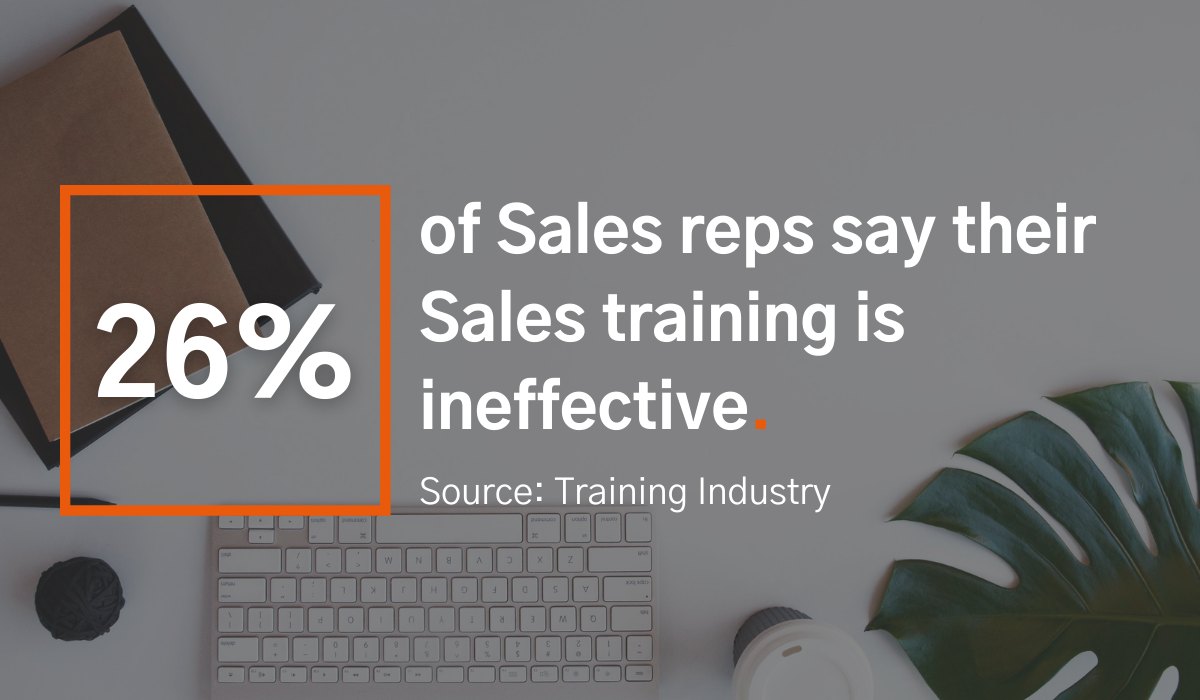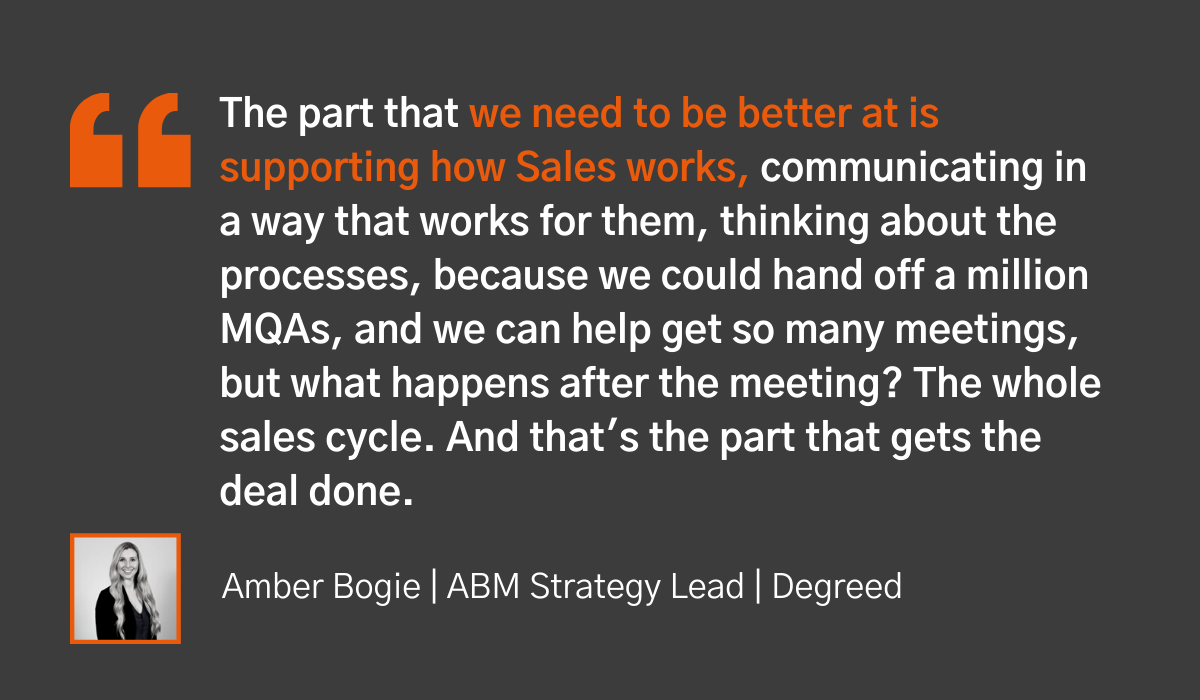Earth-shattering news. ABM is not Marketing.
There. Now we have your attention.
I’m often asked what Marketing is. Now we can be all proud (and precious) of our work but, ultimately, our job is to make sales easier.
That is it. In a nutshell our job is to make our Sales colleagues close deals faster and bigger.
When it comes to ABM, our singular focus is Accounts.
Winning, growing, and retaining our most important customers
And sales enablement is the ultimate weapon in our ABM arsenal.
With all the hard work done of agreeing on your ICP, selecting the right accounts, commissioning insights, crafting a unique value proposition, creating an impactful account experience, etc. you now have all the building blocks to help your Sales colleagues succeed.
"The foundation of sales enablement strategy is to provide salespeople with what they need to successfully engage the buyer throughout the buying process." - Gartner
So where do you start when implementing sales enablement across your organization?
In this insight, we’ll explore:
- Why sales enablement is so important for ABM
- What results you can expect to see from sales enablement
- Tips and tricks for implementing sales enablement in your organization
Sales enablement - why does it matter?
Account-based Marketing relies on insight and knowledge from Sales to engage target accounts.
Your Sales team is on the front line and they know the target accounts better than anyone.

Sales enablement is not a one-off initiative.
It needs to become a culture, an attitude, that is implemented throughout the entirety of your organization, as it will ultimately impact your entire process - from staff onboarding to ongoing training and development.
If you can get that culture right, then your salespeople may well be in a position to lead you to ABM success.
So let’s take a look at some key steps to include on your sales enablement journey.
7 tips for implementing sales enablement
1. Assess the current state of your sales process
You won’t know where you’re going until you understand your current position.
So first thing’s first: assess the current status of your Sales team:
- What processes are currently in place?
- What resources are your salespeople using to engage decision-makers?
- What technology is available to support the sales process?
- How aligned are your Sales and Marketing teams?
And - what’s actually working?
If you can highlight the areas in your sales process that need more support. This will make it easier to determine areas for investment.
Whether this is your content strategy, supporting technology, or the channels used to reach out to decision-makers, auditing the Sales process is your first port of call before you can implement sales enablement across your organization.

2. Create an enablement charter
Once you’ve assessed your current position, it’s time to build a roadmap for where you want to be.
That’s where the enablement charter comes in.
Sit down with your C-Suite, your Executives, your Sales team, and any other teams that will be involved with the sales enablement process, and start to document expectations, goals, challenges, etc. within the Sales process:
- Where do you want to be with your Sales process several short, medium, and long-term?
- What financial goals do you hope to reach?
- How do you expect your Sales process to change and evolve with the enablement program?
From here, you can formalize your roadmap for implementing sales enablement. Write down the what, why, who, how, and when of your sales enablement program.
This will be your guiding light. Your North Star.
And it should be shared with your entire organization to ensure everyone is on the same page and understands what’s expected of them on the journey.
3. Focus on alignment
A key step in implementing sales enablement is achieving true Marketing and Sales alignment.
Because without alignment, you’ll never get the best out of your Sales team.
Did you know, Sales and Marketing misalignment costs businesses $1 trillion each year in decreased Sales productivity and wasted marketing efforts?
Alignment is important!

So what does this mean for your organization?
It means you need to align on goals, metrics, content, process, and everything else in between.
Get Marketing and Sales on the same page, and you’ll quickly notice the changes to your ABM results, not to mention the overall culture within your organization.
4. Leverage content
The content you produce doesn’t just benefit the target audience.
If used correctly, it can also transform the Sales process.
And yet, enterprise organizations lose over $2.3 million each year because of opportunity costs associated with underused or unused marketing content.
So where are these businesses going wrong?
Communication.
Sales should not only have input when it comes to content generation - after all, they know what content registers best with key decision-makers - but they should also use content to aid the Sales process.
With 84% of sales executives citing content search and utilization as the top productivity improvement area, and only 35% of Sales teams tracking the effectiveness of their content, it’s clear that there’s a long way to go when leveraging content in Sales.
But with the right content supporting your Sales team, your brand’s message will be that much stronger, and your salespeople will begin to be viewed as trustworthy advisors.
5. Invest in supporting technology
B2B Marketers love their tech stacks.
Our usual advice here would be to limit your tech stack wherever possible.
When it comes to Sales, that advice remains true. But it’s wise to invest in a few technologies to support your process.
So what kind of tech should you be looking to invest in?
With ABM, Sales processes are often long and complex, with some deals taking months or even years to close - so you may want to consider investing in automation tools.
In fact, 61% of over-performing sales leaders use their CRM to automate parts of their sales process, vs. 46% of under-performing leaders.

When it comes to account insights, tools such as LinkedIn Sales Navigator are a must.
CRMs such as Salesforce and HubSpot can help to manage account insights, automate processes and provide a single view of your accounts and the sales pipeline.
Remember; you still want to keep your tech stack as streamlined as possible. And expanding on existing software like your CRM is often a good way to go.
But don’t be afraid to invest in a select set of tech that can work together for results.
6. Invest in training
You can invest as much money as you like into technology, resources, and boosting company culture, but if your Sales team isn't getting adequate training, your money will go to waste.
To really get the most out of your Sales team, they need support, coaching, and training opportunities to help them advance and to keep your sales process aligned across the entire team.
This is particularly important when it comes to ABM.
Why?
Because the ABM Sales cycle is not the same as more ‘traditional’ sales cycles.
It calls for additional training and education to ensure everyone is aligned and executing the same process.
And if you still don’t believe that training is important, here are some compelling numbers to convince you:
- Effective Sales coaching can improve win rates by as much as 29%.
- 26% of Sales reps say their Sales training is ineffective.
- 84% of Sales training is forgotten in the first three months.
- If your sales reps don’t feel they are learning and growing in your organization, you’re at risk of losing upwards of 60% of your entire workforce within four years.
- 27% of companies don’t have an onboarding process for salespeople .
If you’re looking to get the most out of your Sales team, training should be top of your agenda.
7. Seek input from Sales
You may think this goes without saying, but shockingly, at least 25% of Sales and Marketing teams continue to operate as independent, siloed departments.
If that’s your organization - you’re not getting the input and buy-in you need from Sales to truly succeed!
Whether it’s about content generation, account selection, or go-to-market tactics, your Sales team should have a voice.
After all, their voice is ultimately the voice of your target accounts - as they are the ones on the front line, communicating with your prospects day-in, day-out.
Consider setting aside an hour or two a week to check in with your Sales team and get their input on these decisions.
Regular meetings will reinforce the value and input that Sales has to offer - and will help bring every team together.

Sales enablement: it's all in the numbers
Sales enablement doesn’t just impact your Sales team - it impacts your entire organization.
In fact, with a dedicated sales enablement program, you could expect to see:
- A 49% win rate on forecasted deals, compared to 42.5% for those without.
- A 6-20% increase in sales.
- A 52% higher probability that your Sales process is tightly aligned with the buyer’s journey.
Now with these types of compelling numbers - isn't it time to review your sales enablement strategy?






